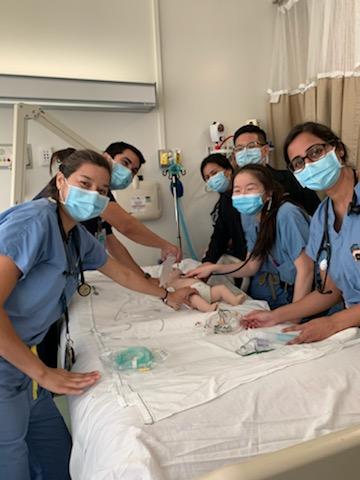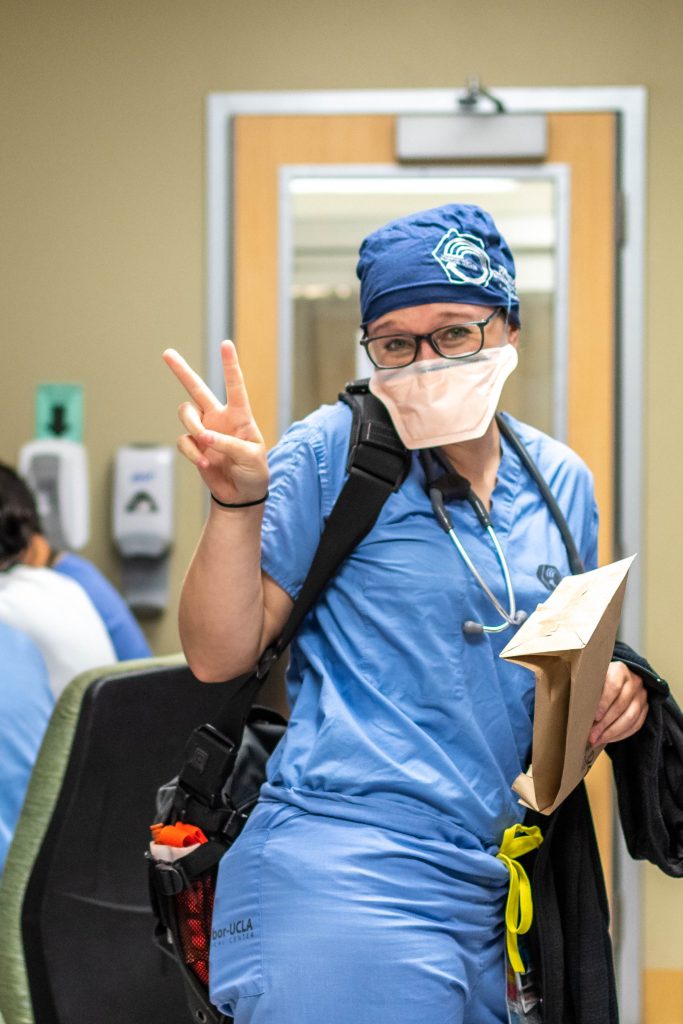An Overview
The Harbor-UCLA Medical Center Department of Emergency Medicine includes an 18-bed separate Pediatric Emergency Department (PED) adjacent to adult emergency department areas, with which it shares a trauma resuscitation bay and imaging facilities. Staffed by residents from Emergency Medicine, Pediatrics, and Family Medicine, the department is supervised by PEM-boarded Pediatrics and Emergency Medicine residency-trained faculty, Emergency Medicine faculty, and Pediatric Emergency Medicine fellows. The PED is a Pediatric Trauma and Pediatric Critical Medical Receiving Center, and it sees around 25,000 patients annually.
Clerkship Overview
We have designed this elective in Pediatric Emergency Medicine (PEM) to familiarize the fourth-year medical student with the care of acutely ill Pediatric patients who present to the PED. Students work one-on-one with a senior resident and the attending, and have the opportunity to see patients ranging from newborns to 20-year-olds. Students will take histories, do physical exams, and come up with differential diagnoses and treatment plans for their patients. They will see three to five patients every day and have many opportunities to learn from their patients as well as patients receiving care from other providers in the department.
Common Pediatric Diseases/Problems Encountered
Some of the common Pediatric diseases/problems students will encounter include fever, URI, otitis media, skin disease/rashes, gastroenteritis, asthma, abdominal pain, pneumonia, trauma, and urinary tract infections. We also care for many injured patients, including those with major and minor trauma such as lacerations and fractures.
Procedures
There are opportunities for several procedures including laceration repair, removal of ingrown toenails, foreign body removal, abscess incision and drainage, and fracture reduction and splinting.
Simulation
Students will have the opportunity to participate in mock codes during their three-week rotation.
Ultrasound
We have plenty of state-of-the-art ultrasound machines in our emergency department. If interested, students will have the opportunity to learn how to acquire and interpret basic bedside ultrasound images during the rotation.
Child Abuse Clinic
Students will spend one afternoon in the child abuse clinic, learning more about the recognition and evaluation of non-accidental trauma.
EMS Ride-Along
Students will spend one day on an EMS ride-along to observe the care of patients before they arrive at the emergency department as well as to gain familiarity with prehospital scope of practice, policies, and procedures.
Weekly Conferences
Students will join our residents for our department’s weekly Thursday didactic conferences. The residents have protected time (during which the faculty staff the ED) to help build their core Emergency Medicine knowledge. Students will also have the opportunity to attend conferences organized by the Pediatric department.
Preparing for Your Clerkship
Please review the following before your first day, to ensure you get the most out of your rotation.
Using the Electronic Medical Record System ORCHID (Cerner)
We have made some videos to help you understand how to better navigate the Electronic Medical Record (EMR) we use. We will also train you in person on your orientation day, but you should review the information included beforehand to make your training more useful. Please check this YouTube training video link to get a basic understanding of ORCHID before attending orientation.
Parking
Parking is available in our parking structure, above level 3. You can check in for orientation in the N-14 building on the map and ask for Rafael Esparza. Here’s the parking map.
Educational Resources
PEMsource.org has several Free Online Access to Meducation (FOAM) links and resources, algorithms, ECGs, and images. In addition, there’s a PEM curriculum that covers common Pediatric Emergency Medicine topics.
PEMplaybook.org is a monthly podcast with extensive shownotes, aiming to demystify the emergency care of infants and children for learners.
Apply
Rotation Dates
For latest academic year rotation dates, see VSLO catalog
Rotations will start on the dates listed. All visiting students must participate in a four-week rotation. UCLA students are required to do at least the three-week rotation but we suggest you do a fourth week if you’re interested in Emergency Medicine.
Applications
You can access applications online via VSLO. Please send an email to Chanel Carter and Lorie Fager, the medical student coordinators, with any specific application-related questions.
Once we accept you for a rotation with us, you also have to meet all the requirements of the Department of Health Services at Los Angeles County for a rotation, which include:
- Health Clearance Packet (E2 Form)
- Background Investigation
- Respiratory Fit Test
- Online Application
You must also complete a Workforce Member form at http://dhs.lacounty.gov/cef. When completing the form:
- Select “New Assignment.”
- The Sponsor Facility is Harbor-UCLA Medical Center.
- The Sponsor Division is Emergency Medicine.
- The Sponsor’s Name is Patricia Padlipsky.
You can find the required forms and Live Scan fingerprinting on the VSLO website, or we will email them to you upon your rotation approval by program coordinator, Rafael Esparza. Please send an email to the coordinators if you have questions about this process.
Contact Information
Rafael Esparza
Medical Student Coordinator
Patricia Padlipsky, MD, FAAP
PED Clerkship Director

